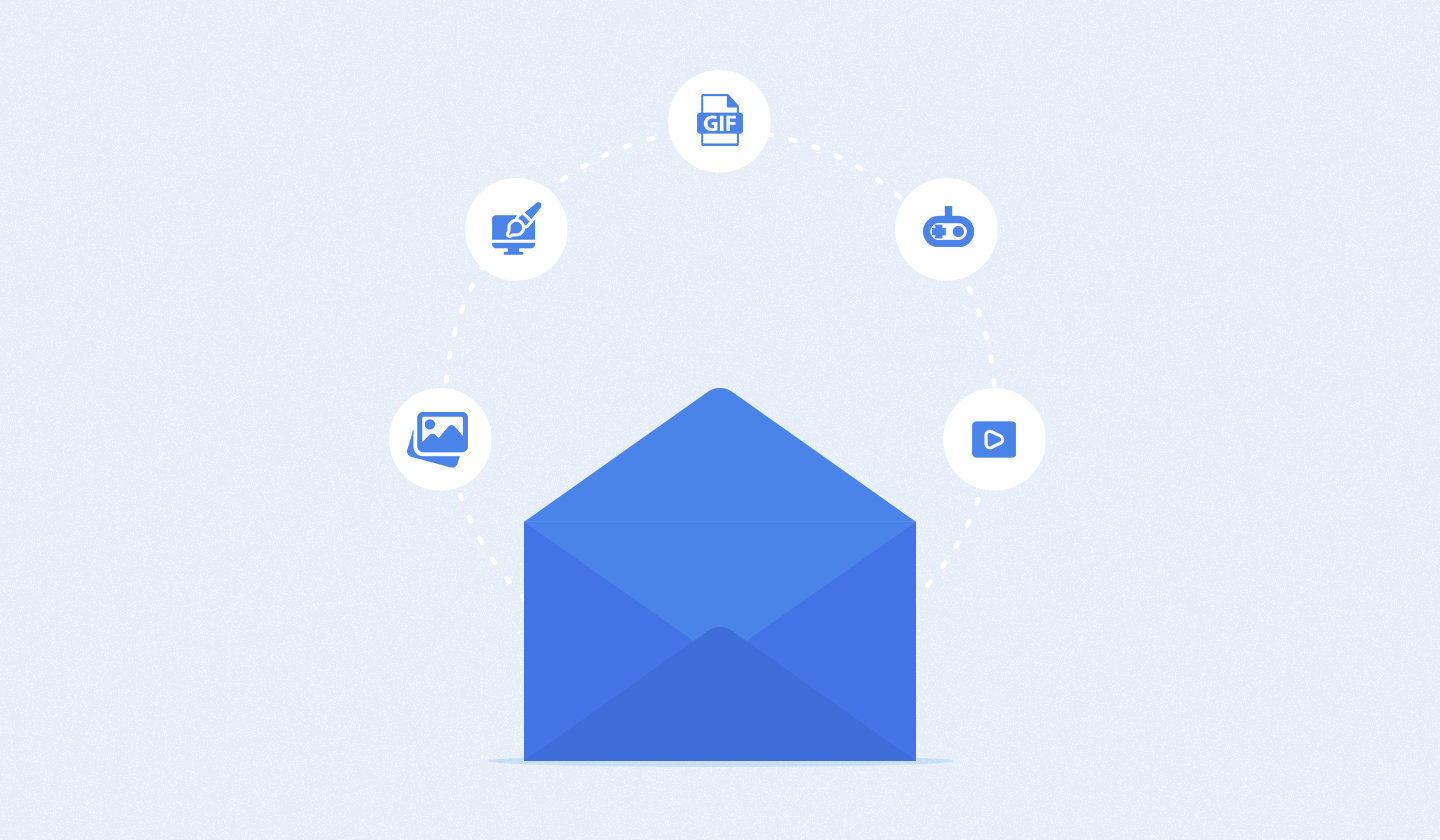Give me 9 minutes of your time, and I’ll tell you 15 fail-safe solutions on how to improve email deliverability.
Sounds like a good offer, doesn’t it?
On average, 20.4% of emails either remain undelivered or go to the spam folder.
If you want to save your emails from being one of them, read this article to learn and follow the best practices mentioned below to avoid failures in email deliverability.
But before that, let’s quickly look at what exactly is email deliverability.
What Is Email Deliverability?
Email deliverability means the rate at which your emails successfully reach your subscribers' inboxes. Conversely, failure in an email’s deliverability means that your email was either bounced, went to spam, or was blocked by your subscriber’s Internet Service Provider (ISP).
Many people fail to distinguish between email’s deliverability and delivery.
And understanding the difference between these 2 is the first step in improving your email marketing campaign’s performance. So, let’s talk about the difference first.
Difference Between Email Delivery and Deliverability

Email delivery occurs when the server of your subscriber’s Email Service Provider (ESP) accepts your email.
It can be measured by dividing the number of emails delivered by the number of emails sent. An email delivery failure can occur because you had the wrong email address, the server no longer exists, or your receiver blocked your IP address.
On the flip side, email deliverability refers to where your message ends up after your subscribers receive it. It is influenced by the sender’s identity, reputation, and the nature of your email’s content.
So, if there’s a problem with your email’s deliverability, you must be concerned about what went wrong and take action accordingly.
To understand email deliverability better, you need to understand its journey first. So, let’s have an overview of the journey of an email.
The Journey of an Email
I’ve explained an email’s journey step by step below to help you understand its deliverability better. Have a look!

Step 1: You create an email list for your campaign.
Step 2: You send emails to your subscribers.
Step 3: Your emails are delivered. Some of these emails might go undelivered due to soft or hard bounces.
A soft bounce occurs when your recipient’s inbox is full, or they suddenly receive a larger volume or frequency of emails from you (sender). Contrarily, a hard bounce occurs when your recipient’s email address is incorrect or no longer valid.
Step 4: Your sent email may reach your subscriber’s inbox, spam folder or hit the spam trap.
Wondering what that is?
Spam trap (or honeypot) is an advanced fraud management tool used by ISPs to identify spammers.
It can either be created with an email address abandoned first and later adopted by an ISP or a brand new email address specifically created for this purpose.
Step 5: Your email is either opened, clicked, unsubscribed, or marked as spam.
This flow of an email might make it easier for you to figure out where a problem lies in case of an email deliverability failure.
Now, let’s move from observing a failure to fixing it by learning some best practices on how to improve email deliverability.
15 Practices That Can Improve Your Email’s Deliverability
Think about the amount of energy, time, and money you invest in creating and sending emails?
And after all this struggle, it’s heart-wrenching to notice that your emails are not performing because of deliverability failure.
You can use the following preventive techniques in your future email campaigns to avoid that.
1. Establish an authentic email domain
No one repulses fakeness more than an ISP. If you don’t prove to them that your email domain is authentic, you might receive poor delivery rates.
You can use email authentication technologies like Sender Policy Framework (SPF) and Domain Keys Identified Mail (DKIM) to prevent any claim of email spoofing and assure the ISP that you are an authentic source.
In addition, you can enable DMARC (Domain-Based Message Authentication, Reporting, and Conformance) to standardize the way ISP analyzes emails with the help of SPF and DKIM. In simple words, it’s an authentication method to prevent spammers with the help of SPF and DKIM.

2. Ensure your IP’s good reputation
Your IP’s reputation can make or break your deal.
ISPs analyze your IP address's reputation by monitoring your behavior and giving you a sender score.
A sender score is given based on the number of inactive subscribers, spam complaints, and whether or not anyone blocked your domain. A lower sender score may result in email deliverability problems.
You can have a good IP reputation by warming up your IP address.
IP warm-up is done by sending low volumes of emails for a significant period and then gradually increasing the volume.
By doing so, your IP address will get approval from the ISPs. You must also try to use an ESP that will not harm your IP’s reputation.
3. Go for simple and well-structured layouts
Your email designs play an important role in their deliverability.
Single-column layouts and simpler emails are easier for your readers and ISPs to understand. Also, people like to engage with simpler emails more, and they are easier to load than multi-column layouts.

4. Tidy up your email list
People say, “A clean space is a safe space,” and I couldn't agree more.
You should regularly clean up your email list by removing your inactive subscribers to improve your email's deliverability. Inactive subscribers may result in a hard bounce and a poor sender reputation.
Besides this, an uncleaned list may also include spam traps.
I understand that cleaning off your email list may sound like saying goodbye to your age-old subscribers, but in reality, it’s just a prevention technique to remove invalid and unengaged email addresses.
5. Use minimal images
If you’re a marketer who loves to embed images in emails, here's a heads up.
You must go for a 70 to 30 text-to-image ratio for your emails to ensure a good email deliverability rate.
Try to keep the use of images in emails as minimal as possible.
For starters, they won’t be visible if your viewer turns off the image viewing option. Secondly, if the ratio is higher than the one mentioned above or there’s a poor internet connection, they will fail to load.
Now to be clear, this doesn’t mean that you avoid adding them. You just have to be wise in their selection, and you’ll be able to create amazing emails that deliver well.
6. Send emails in small batches
Try to send your emails in small volumes or clusters rather than large volumes.
Many email providers have a daily rate limit of receiving emails to prevent spam from reaching their subscribers' inboxes. In addition to this, ISPs also have a daily rate of emails they like receiving from a particular IP address.
If you cross that limit, your emails will receive a soft bounce because the server will surpass the limit of emails to receive.
Even though the server will resend the emails after 72 hours, you must send emails in small clusters to avoid landing in such a situation in the first place.
7. Add engaging elements
Here’s the thing.
Engaging or interactive elements in emails can be your knight in shining armor. Trust me when I say this.
Statistics show that interactive elements in emails increase click-through rates by 73%.
In simple words, an interactive element can be anything that encourages readers to take action, such as videos, GIFs, CSS animation, a call to action button, etc.
You will encourage your audience to interact with your emails by adding them, and this high engagement will lead to a better IP reputation and email deliverability rate.
8. Avoid spammy words and symbols
Well, I can’t stress enough on this one.
Avoid anything that can lead your email to the spam folder. This includes over-using salesy words like “free,” “earn,” “act now,” etc. Also, avoid capitalizing a whole word and adding exclamation marks.
Besides this, your email design can also consist of elements that might feel like spam, such as a warning sign or overuse of bright colors.
Another important factor here is to avoid misleading or incorrect subject lines that can make your email land in the spam folder.
You’ll need to be especially careful while drafting your promotional emails because they require such content and have a high chance of landing in the spam folder.

9. Create opt-in or double opt-ins
You can only create a valuable subscriber list if they receive emails with their consent. And you shouldn’t leave any stone unturned in this process.
Try to send emails to people who volunteer and opt to get emails from you only.
You can also include permission reminders or double opt-in forms to have an even cleaner email list.
Double opt-in is a process of adding new contacts to your email list. First by collecting email addresses through sign-up forms and then by sending confirmation emails to the subscribers who signed up. This way, your subscribers give consent for receiving emails twice.
Double opt-in forms are CAN-SPAM compliant, resulting in a better quality of email lists, increased engagement with subscribers, and reduced risk of landing in spam.
And an active and qualified email subscriber list results in a better IP reputation and improved email deliverability.
10. Add a prominent unsubscribe option
I know you might be wondering that prominent unsubscribe options are a big no-no. But trust me, an unsubscribed user is far better than someone who reported you as spam.
Yes, that’s right, 50% of subscribers mark an email as spam because they find it hard to unsubscribe.
So design all your emails in such a way that the unsubscribe option is visible and easily engageable.
The cherry on top will be to send them confirmation emails that they have been unsubscribed. You can also gather some feedback on why they wanted to unsubscribe in the first place.
This may not bring them back, but it will be a good opportunity to collect their valuable feedback and improve.
On a very important note, you should enable your recipients to unsubscribe with a single link. Since they’re already agitated, the last thing they want from you will be an extensive unsubscription process.
11. Select the right frequency
Give your beloved subscribers control over the emails you send; they’ll adore you for that.
You can allow your subscribers to select the frequency of emails they receive from you (such as twice a month, once a month, etc.) and the kind of emails they receive from you (as in which topics they would like to receive emails on).
This practice will prevent them from unsubscribing from your email list.
As sources reveal, 59% of people unsubscribe from an email list because they received emails too often, 38% unsubscribe because the email is irrelevant, while 11% value customized content.
12. Segment your subscriber list
If you haven’t yet paid heed to the segmentation of your email list, then there’s a major loophole in your email marketing campaign.
Email list segmentation allows you to reduce the number of unengaged subscribers by sending them personalized or triggered emails.
Yep, you read it right.
Marketers who segmented their email list noticed a 760% increase in their revenue.
When ISPs notice that your subscribers engage with your emails, they start trusting your IP address. In addition to this, segmented email lists also reduce the number of reported emails, increasing the chances of email deliverability.
You can segment your email list according to their demographics, interests, purchase history, behavior, etc.
Remember that your goal is to make things interesting, relevant, and engagement worthy for your subscribers.
13. Have a recognizable brand image
A major factor that affects email deliverability is inconsistent brand image.
If your emails aren’t sent from a consistent brand name or if they don’t follow a particular design theme consistently, the chances are that they might get reported.
You must add some brand elements to your email designs to avoid this, for instance, a logo, brand’s color theme, or a certain style.
Let’s say I have a furniture brand that always went for minimalistic email designs and suddenly started switching to louder designs; this may confuse my viewers and result in lower engagement.
Lower engagement further results in poor deliverability rates.
Moreover, you should also be consistent with your sender name. Try to send them emails from a single and brand-centered email address, such as xyz@unlayer.com.
A recognizable sender name reduces the chances of getting your emails flagged, so make sure you consider this.
14. Avoid purchasing lists
Again this is something I can't emphasize enough on.
Avoid purchasing email lists at all costs. Even though it may sound like a wise idea to buy many subscribers, but here’s the deal: your purchased email list may consist of spam traps, inactive subscribers, etc.
Such email addresses can only harm your IP address's reputation and, as a result, your email’s deliverability.
Have you ever heard people say less is more?
That is applicable in this case because an email list with fewer subscribers and engaged users is more precious than a purchased long list with unengaged users.
15. Always choose responsiveness
Imagine creating a jaw-dropping email design that doesn’t load on your subscriber’s mobile phone because it wasn’t mobile-friendly?
Won’t all your efforts go in vain?
Of course, they will. To avoid this, you must create responsive email designs just like Unlayer’s email templates.
After all, more than 50% of emails are opened on mobiles. You won’t risk leaving them out, would you?
All these tips seem simple and doable, right? Then start implementing these practices in your campaigns.
Wrap Up
I’m sure this article was no less than a stress reliever for you.
After all, it’s pretty worrisome to witness your carefully created email campaigns not performing the way they should ideally.
But now, you don’t need to worry about that because this article has provided you with all the necessary information needed on how to improve email deliverability.
Incorporate these practices in your email marketing campaigns, and you won’t face any email deliverability problems in the future.
Found this article insightful? We have a few other blogs that you might be interested in as well. Have a look!





